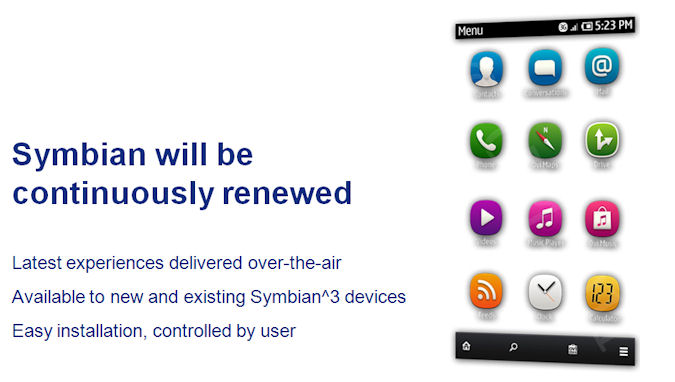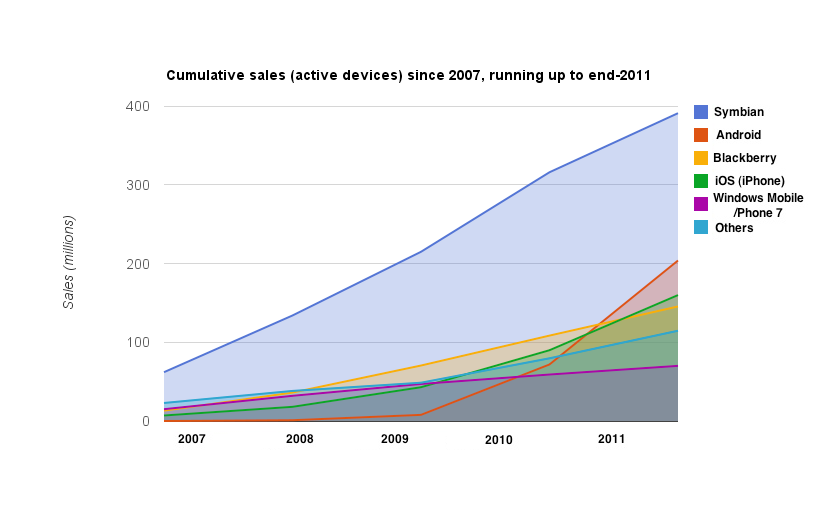Planned new devices and updates
At the Sunday event at MWC on February 11th, Nokia's Jo Harlow clearly stated that there would be new Symbian devices from Nokia in 2011, some with 1GHz+ processors. Nokia's timescales for conceiving a device, designing and then producing it, are between a year and 18 months and it's fairly clear that there will be several smartphones in the pipeline which haven't been announced yet but which will see the light of day in large numbers. There will almost certainly be new devices in 'Touch and Type', QWERTY candybar, touch-only and QWERTY hybrid form factors, Nokia's stated target is another 150 million Symbian smartphone sales over the next few years. This is a marked decrease from the 100 million a year level Nokia had been running at (e.g. in 2010), but still an astronomical (and market leading) number, for a single manufacturer at least.
Backing this up, I noted a tweet from a reliable industry source, Brendan Arndt, a product manager at 3, in which he said "Today I got to see some amazing stuff from #Nokia. #Symbian is so not dead. Just wait till you see what's coming".

Jo Harlow also promised a continuing programme of software updates for Nokia's Symbian^3 phones, including user interface enhancements. Not just a new browser and portrait QWERTY keyboard, Jo went one step further at an event in China, showing a drastic reworking of the Symbian homescreen, including multiple widget sizes.
In short, Nokia really does seem serious about supporting its Symbian phones fully - throughout 2011 at least, and it's fair to think that they'd be remiss if they didn't carry on updates right up until the point where Nokia's Windows Phone hardware was actually on the market and selling well.
An enormous cumulative base
Even if you discount Symbian-powered phones shipped before 2007 (on the grounds that these will now be too old to count and possibly now disused - including popular devices of their time like the Nokia N80, 9500, N70 and E61, though even here I'd argue that many are living happy second lives with relatives in many cases), the installed base of Symbian smartphones is huge. And I mean huge. Nokia's dominance in the smartphone world for the last four full calendar years (now challenged by Android, but only very, very recently) has meant a mass of anything between 200 and 300 million devices, depending on when you start counting and what devices you actually count. Think about that number again for a moment. 200 to 300 million active Symbian devices and their users.
I prepared the chart below on February 14th, as I got my thoughts in order after Nokia's announcements, though I was rather tickled to see a similar one produced (entirely coincidentally) by Asympco just last week, which drew out similar thoughts to those suggested here. The thing to notice in the chart (which goes from the start of 2007 - the year of the N95 and original iPhone - to the end of 2011, using informed guesses at platform sales for each OS in the latter case) it that it tracks cumulative sales, i.e. the total installed base of 'compatible' smartphones, growing quarter by quarter for every platform:

Each user will be looking for updates, for support, for software and, ultimately, for an upgrade path. You'll note that I stuck 'compatible' in quotes above, since there's distinct fragmentation in each mobile OS, with older devices and OS versions not necessarily compatible with newer software. This even applies to iOS and Android, notably, though I'll accept that Symbian has a touch (pun intended) more fragmentation than the others. But no OS is perfect in this regard.
Even allowing a margin of error for my guesses for 2011 platform sales, and even allowing a fudge factor for poorer compatibility across the generations, I hope it's clear to see that the approximate total number of Symbian-powered smartphones in active use (sold in the last four full years, since the start of 2007) is around 300 million, compared to just over 100 million for Blackberry and less for the newer iOS and Android contenders. In fact, based on these figures, as at the end of 2010, there are more active Symbian smartphones around the world than for all other smartphone platforms put together.
Look, this isn't a blind defense of a platform in its twilight years - I can see the end of active development in sight as well as the next analyst. But don't let anyone say that Symbian smartphones are going away anytime soon. It will be several years before any other smartphone platform gets close to the same installed base.
In short, there's huge inertia behind Symbian, behind its platform variants, and behind the devices in use around the world.
The enthusiastic long tail
Here's a cautionary tale, and one that I've mentioned before in various podcasts. I made my name by distributing (and writing) Psion shareware back in the 1990s, pre-Internet. Psion sold over two million SIBO or EPOC (Symbian's oldest ancestor) palmtops in their seven year glory period (1992 to 1999) - it seemed a lot at the time - but withdrew from the market in 2000. So it has been eleven years since the last Psion was sold at retail. And yet today there's still a surprising sub-culture of Psion palmtop sales, repairs and software exchange.

The Symbian smartphone ecosystem is approximately a hundred times larger - care to place a bet how long this will take to wither? No matter what happens to Symbian as an OS from 2012 and 2013 onwards, there will be enthusiasts writing articles and tutorials, swapping software, trading tips and more, well beyond 2014/2015/2016.
I'd wager that there will be Symbian enthusiasts, much like you and I (if not you and I specifically - who knows!), gathering on a site like this a decade from now, in 2021. Now that's either scary or reassuring!
________________________
Quite apart from needing to be convinced by the reasons above, the device in your pocket (perhaps an N8 or E72?) is still as functional as it was before February 11th. None of its software will stop working tomorrow. Or next year. Or the one after that.
Yes, Symbian OS development will slow through 2011 and stop some time in 2012. But neither the OS, this community, or I personally, are going away.
I talked in the last AAS Insight podcast about Symbian being near the end of an 'evolutionary curve'. That's not the same as 'about to die'. To use a metaphor, think of Symbian OS as a person. It's hitting retirement age, which means it's not going to be trained up any more and may well need patching up a bit in the upcoming years. But, like most pensioners these days, it seems - certainly the ones I see in their 60s and 70s whacking golf balls on the nearby course all week - just because you're retired doesn't mean you can't do a lot and have a great deal of fun.
Steve Litchfield, 28 Feb 2011
